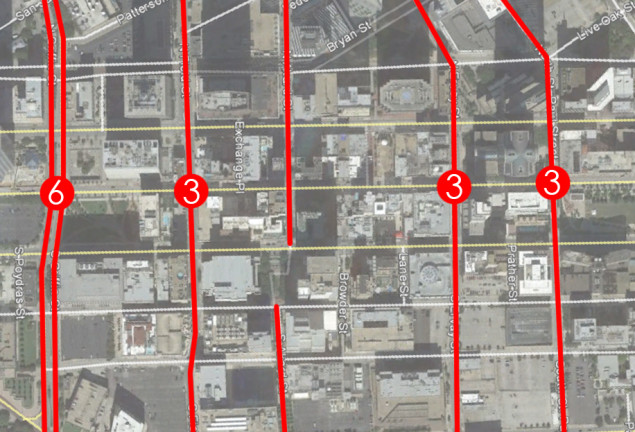I was in Portland for a long weekend last August when it’s the perfect time to get away from Dallas and spend a vacation in the Pacific Northwest where it was 75 and sunny. Sort of like a Dallas spring day. Like today.
Portland has many lessons, most of which are far deeper than bikes, food trucks, and the dream of the 90’s. The 1890’s.
It was probably the fourth time, I had visited Portland in my lifetime, each time with a new perspective. On the most recent visit, what struck me the most was how little vehicular congestion there was at all hours of the day.
Portland has very small blocks and fairly small rights-of-way. Sure, they have some bike lanes and some light rail lines occupying a few lanes, but the vast majority of the rights-of-way are still dedicated to cars.
One reason for lack of vehicular congestion of course is mode share. Citywide, Portland commutes by private automobile at a rate of 68.08%. City of Dallas (not metro) is at 88.27%. It’s also a smaller city, but I don’t find city size too relevant to issues of congestion because most cities typically drop a similar amount of pavement per capita. The difference is in street network design.
I like comparing downtown Portland to downtown Dallas because both were built of a similar era, designed on grids, and canted on an angle to break up some of the monotony of the grid.
If we look at the downtown grids of both downtown Portland and Dallas, and then isolate the north-south links (you can do the same with E-W to make same point), in order to come up with a proxy for capacity (and for the purpose of this demonstration, I’m talking only vehicle capacity. If we added pedestrian, bike, and transit connectivity, you’ll have some understanding for that 20% gap in car commuting rates).
Counting the amount of north-south travel lanes, we get 25. Because Portland’s streets and blocks are so small they can get away with a predominantly one-way system. Rights-of-way are often only about 50 feet across where they typically squeeze in three vehicular travel lanes and some parallel parking if space permits. Where they drop to 2, they often have either dedicated tramways or bike lanes.

Whereas in Dallas, the grid is so fractured and fragmented, that at the same scale, we have way less connectivity. There are only a total of 15 travel lanes. Ten less than Portland in the same land area. Keep in mind, the small city blocks also disciplines development in order to engage the street and maximize the most valuable real estate, the frontage (or on upper floors, the views).

If you want to count East-West connections because of Dallas’ rectilinear blocks, that number is still 22-14 and it gets worse for Dallas if you scroll further north or south from these particular areas. Either direction, Portland has many more connections than does Dallas in the same amount of area.
If we want to add in transit and pedestrian connections, the math looks more like this: 25+4+22 = 51 (Portland) vs. 15+0+8 = 23.
The reason for this limiting of capacity, of course, is that we’ve subjugated the grid (and in many ways the functions of the city) in order to serve the highway system. Local connections, the kind necessary for vibrancy and neighborhoods to exist, are severed in order to create regional connections. The result is diminished livability in pursuit of escape routes. Here is the real nature of our street network and interconnectivity:

This is where downtown congestion comes from. It’s partially because of the lack of capacity downtown, but that comes from the highways disconnecting the grid. All too often, like we saw during the recent wintery weather where surface streets were fine, the congestion is simply the highways backing up into the city.
To build a better city, we have to ensure that transportation infrastructure is subservient to the functionality and viability of the city, not vice versa. Otherwise, imagine if our brain existed in order to tell are circulatory system to pump blood. The priorities, the hierarchy of living systems defining our humanity, that allow us to exist would be out of order and we would cease to exist.
It’s not really any wonder that the only thing that killed cities, not plague nor the poverty and disease of industrialization, was the primacy of highway infrastructure imposed upon them from the second half of the 20th century.





